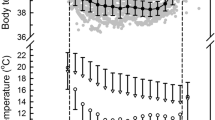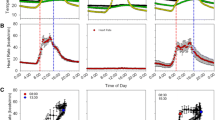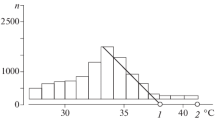Abstract
Two species of the genus Acomys coexist in arid zones of southern Israel. Acomys russatus is distributed in extremely arid areas, while A. cahirinus is common in both Mediterranean and arid regions. Individuals of both species from a rodent community in the Ein Gedi Nature Reserve were implanted with temperature-sensitive transmitters. Body temperature (T b) rhythms were recorded in free-ranging mice at four different seasons of the year. A. cahirinus (30–45 g) showed a nocturnal rhythm of T b throughout the year. In the activity phase during the night T b increased to 38.2°C. During the day T b decreased to 34°C. This species displayed this pattern in summer also when ambient temperatures rose above T b. The T b of A. russatus (45–65 g) varied between 34.8 and 41°C during the hot season, showing a bimodal temperature rhythm with maximal values in the morning and in the evening. Measurements of activity in this species showed inactivity during the hottest period of a summer day. In winter A. russatus showed no clearly detectable diurnal or ultradian rhythm in T b, which remained constant between narrow limits of 35.2 and 36.8°C.
Similar content being viewed by others
Author information
Authors and Affiliations
Additional information
Received: 21 December 1998 / Accepted: 15 March 1999
Rights and permissions
About this article
Cite this article
Elvert, R., Kronfeld, N., Dayan, T. et al. Telemetric field studies of body temperature and activity rhythms of Acomys russatus and A. cahirinus in the Judean Desert of Israel. Oecologia 119, 484–492 (1999). https://doi.org/10.1007/s004420050811
Issue Date:
DOI: https://doi.org/10.1007/s004420050811




